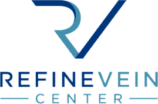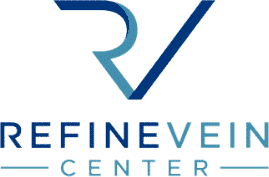If your legs feel heavy at the end of the day, your ankles swell, or you notice prominent veins, you’re not alone. These are common signs that your veins are working harder than they should. One of the simplest, most proven tools to help is medical-grade compression socks (sometimes referred to as “compression stockings”). Below, we’ll explain how compression socks support vein health, when they’re prescribed, and their real-world benefits.
What “Medical-Grade” Compression Really Means
Medical-grade compression socks apply a precisely measured, graduated pressure that’s strongest at the ankle and gradually decreases up the leg. This gradient gently “pushes” blood upward toward the heart, supporting vein valves and reducing venous pressure in the lower legs.
At Refine Vein Center, compression is part of a larger, evidence-based care plan designed to lower venous pressure and restore healthy blood flow so symptoms improve and legs look and feel better.
Unlike merely tight over-the-counter socks, medical-grade compression is prescribed (or specifically recommended) after a clinician evaluates your symptoms, ultrasound findings, and lifestyle. The correct strength and style can vary widely from person to person, which is why we determine the right stocking strength during your consultation.
When Is Compression Prescribed?
1. First-Line Conservative Care
Many insurance plans expect a trial of conservative measures (typically 6–12 weeks) before covering more advanced vein treatments. Graduated compression stockings are a key part of that trial and can reduce pain and swelling while you and your provider evaluate next steps. Note that some insurance plans do not require these conservative approaches before moving on to advanced treatments. Contact our team today to find out what your insurance provider requires.
2. After a Vein Procedure
If you undergo a minimally invasive treatment, your care team may advise compression during the healing period to support circulation, reduce bruising and swelling, and help results set in properly.
3. Symptom-Based Use
Compression is commonly recommended for symptoms tied to venous insufficiency, such as leg swelling (edema), aching, heaviness, nighttime cramps, and tenderness (especially after long periods of sitting or standing).
4. Special Situations
Pregnancy increases blood volume and vein pressure in the legs. Compression can be a helpful, non-drug support during this time. It’s also useful for long travel or jobs that keep you on your feet.
How Compression Helps: Practical Benefits
- Less Swelling: By counteracting gravity and venous pooling, compression limits fluid from accumulating in leg tissues, often the reason shoes feel tight by evening.
- Reduced Aching, Heaviness, and Fatigue: Lower venous pressure typically means less throbbing and end-of-day leg fatigue.
- Support for Vein Valves: Graduated pressure assists the one-way valves inside the veins, encouraging upward blood flow and helping manage chronic venous insufficiency (CVI).
- Smoother Recovery after Treatment: After treatments for varicose veins, compression socks support the treated area and can improve comfort during recovery.
What to Expect at Refine Vein Center
Your visit to Refine Vein Center begins with a thorough assessment, often including a duplex ultrasound, to identify whether chronic venous insufficiency, varicose veins, or another issue is driving your symptoms.
From there, we tailor a plan that may begin with conservative measures like medical-grade compression, leg elevation, and movement strategies. If your ultrasound shows underlying reflux that needs attention, we’ll discuss targeted, minimally invasive options and exactly where compression fits into your timeline.
Getting the Fit and Wear Schedule Right
Because compression socks have to be snug to work properly, correct sizing and donning techniques are important. We’ll guide you on the best length (knee-high vs. thigh-high), fabric, and daily schedule based on your symptoms and routine. The most common wear pattern is during waking hours, especially when you’ll be seated or standing for long periods, and off at night unless otherwise directed. Your provider will specify duration and strength for your unique situation.
Here are a few tips:
- Put stockings on first thing in the morning when swelling is minimal.
- Smooth out wrinkles to avoid pressure points.
- Wash according to instructions so the elastic fibers maintain their effectiveness over time.
When Compression Isn’t Enough
Compression manages symptoms and supports recovery, but it can’t “cure” weak or damaged vein valves. If your discomfort persists, your swelling worsens, or skin changes appear around your ankles, it’s time to evaluate the underlying cause and consider more definitive treatments that directly address reflux. Early intervention can prevent progression to more advanced stages of vein conditions.
Ready to Feel the Difference?
Whether you’re just starting with compression socks or you’ve tried it and still need relief, Refine Vein Center can help you chart a clear path forward, from the right stocking strength to state-of-the-art treatments when appropriate.
Schedule a consultation with Dr. Reynolds and our team to get a personalized plan for healthier, more comfortable legs.



